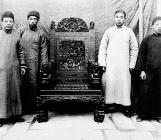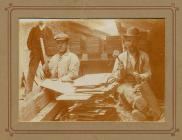The National Eisteddfod's Competitions 1933 and 2011
Items in this story:
Wrexham National Eisteddfod – 1933 a 2011
Something which changed substantially during the twentieth century was the National Eisteddfod’s competitions. Much has been written over the years about the festival’s literary entries, looking at poetic fashions and trends. But very little has been written about some of the more unusual competitions, which appeared in the List of Competitions during the first half of the last century. This was the heyday of the practical competitions, a genre forgotten for many years, but one which remains an important and interesting part of the National Eisteddfod’s history over the past 150 years.
The old Lists of Competitions and Official Programmes are fascinating to read, and show the vast variety of competitions which existed every year. We will concentrate on the competitions in 1933 in this article, which provides us with an interesting snapshot of competitions during this pre Second World War period.
Wrexham was home to the Eisteddfod that year, and this was the festival’s first visit to the town for twenty one years. The List of Competitions in 1933 is very different to the list published last year for the 2011 Eisteddfod, with whole sections from the early years omitted by today.
For information, the title of the Awdl in 1933 was ‘Harlech’ and the Chair was won by Edgar Phillips. Unlike the other two Wrexham Eisteddfodau of the twentieth century, the 1933 festival did not boast a ‘double’ (the same person winning the Crown and the Chair). The title of the winning poem for the Crown was ‘Round the Horn’ although poems on the subject of ‘In the Country’ or ‘The Beautiful Voice’ would have been accepted. The winner was Simon B Jones. But our aim is to dig deeper into the List of Competitions and the Official Programme to find some of the interesting snippets, which make the history of the National Eisteddfod a unique and important part of the history of Wales over the past 150 years.
Disappearing Competitions
One section which has long disappeared from the List of Competitions is the industrial crafts section, at the height of its popularity around 1933. The prizes in this section were very generous, and the competitions could attract a high number of entries.
The competitions concentrated on local industries, and in 1933, with the Eisteddfod in Wrexham, coal mining was the subject for a number of competitions. A prize of £10 was offered for an essay on the ‘North Wales Coalfield, its geographical features and correlation with other fields’, and £5 was the prize for the best essay discussing the ‘Hydrogenation of Coal, with suggestions for its successful development in the North Wales coalfield’.
One of the most unusual competitions in this section was number 150, Shot Firing and Gas Testing. The Programme states that the competition would include ‘Practical and oral examination. Due regard will be paid to the Candidates’ knowledge of the explosives used in coalmines, and of the gases produced by the use of such explosives, and of the steps taken to prevent the possibility of explosion when detonating charges at the Coal face.’ Although the prize was generous - –a first prize of £3 3s, £2 2s as the second prize and £1 1s as the third prize, donated by F. L. Major, Agents for Nobels Explosives Co., Ltd, Shrewsbury – there were no entries in this competition
Architectural competitions
The architectural competitions in 1933 were also interesting. The Eisteddfod still awards ingenuity and flair in this field with the Gold Medal for Architecture, which is one of Y Lle Celf’s main awards. But the needs of the 1930s were very different to the needs of today, and the competitions were very much ‘of their time’.
There were fourteen entries in competition No. 157, Design for a Country Petrol Station. Professor Reilly of Liverpool was the adjudicator, but there are no more details about this competition in the Programme. Seven entries were received for the Arrangement and Design Competition, which had to be ‘drawn to scale of a Road Transport Station, to be built on the Parking Ground, King Street, Wrexham, with separate arrival and departure platforms and waiting rooms, 400 feet by 150 feet level surface’. Professor Reilly also adjudicated this competition, and the prize was generous - £10 for the best design.
The Applied Art section of the Eisteddfod was also very interesting during this period, with a number of practical competitions, providing an opportunity for people to exhibit their skills in a wide range of disciplines.
One sub-section that year was Quarrying, and with the Eisteddfod held in a quarrying area, it’s easy to see why these competitions existed. Competitors had to create ‘a Block of Slate, suitable for a Hall Table Top, with carving in Bas Relief of the Coat of Arms of one of the Welsh Counties’. The prize - £4 4s – was very generous – but unfortunately, there were no entrants in 1933.
List of competitions
Four entries were received in competition No. 173 in the Brick and Pottery section, which required a Model of Regimental Goat in Bas Relief in Terra Cotta or Model of Welsh Dragon in Bas Relief in Terra Cotta – it would be interesting to see the entries for the prize of £2 2s, donated by Professor T Samuels M.Sc, from Wrexham’s Technical Institute.
One can only imagine how these entries would reach their destination. How would the four entrants in the above competitions ensure that their models of Regimental Goat would reach Wrexham in one piece? It would have been even harder to deliver the work required as part of competition No. 172, Model or full-size artistic antique fireplace of brick, to Tom Carrington, the General Secretary of the 1933 Eisteddfod in one piece! We would like to hear from anyone who can shed any light on this subject.
There were all types of handiwork competitions in the Eisteddfod during the first half of the twentieth century – from a collection of grasses or flowers in album form with notes, and a coal-glove or teapot holder, in any material, to two pages of highly popular competitions in the Ornamental Confectionary section, including wedding cakes, birthday cakes, marzipan work, Battenburg and Yule Logs (not to exceed 2 lbs each). But these competitions were not open to everyone, as the Programme stated that they were ‘Open to students who have attended a recognised Bakery School during sessions 1931-32, 1932-33’
So the 1933 List of Competitions was very different to this year’s list. The wide range of competitions offered everyone a chance to showcase their skills in one form or another, almost eighty years ago. Who knows what role existed for these types of competitions in a cultural festival promoting the Welsh language. But all this changed over the years as the Eisteddfod and Wales further developed, until we reach the festival of the twenty first century and the 2011 competitions, which will be adjudicated over the next few months as we approach the Wrexham and District National Eisteddfod.
Do you have more information or images associated with this story? Be a part of the People's Collection Wales, and upload your own items!



